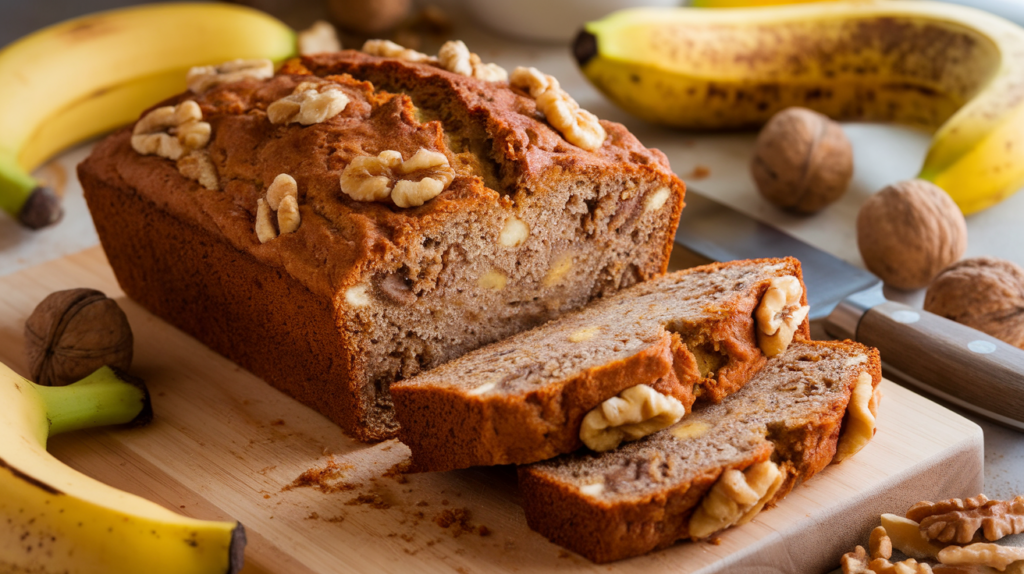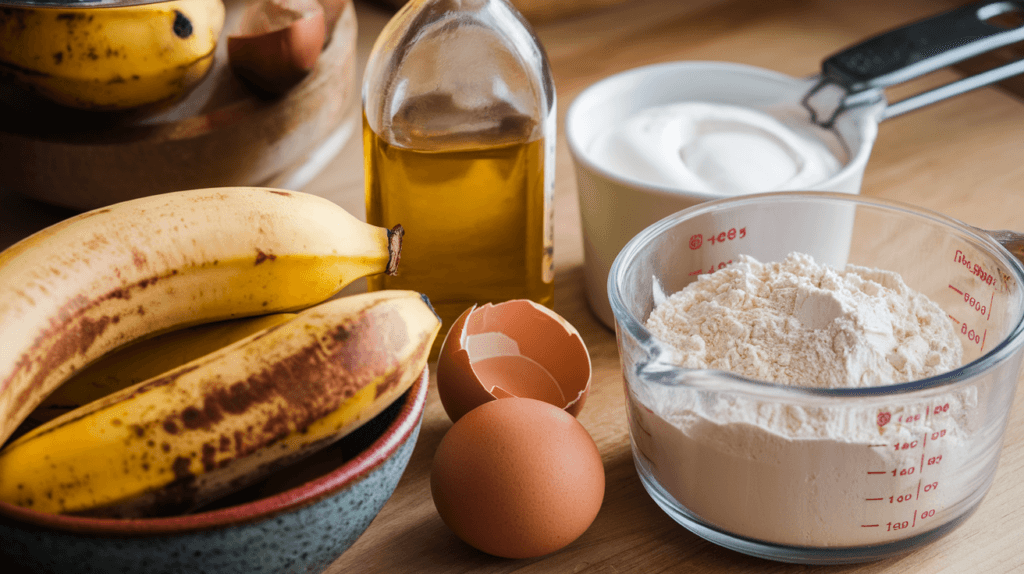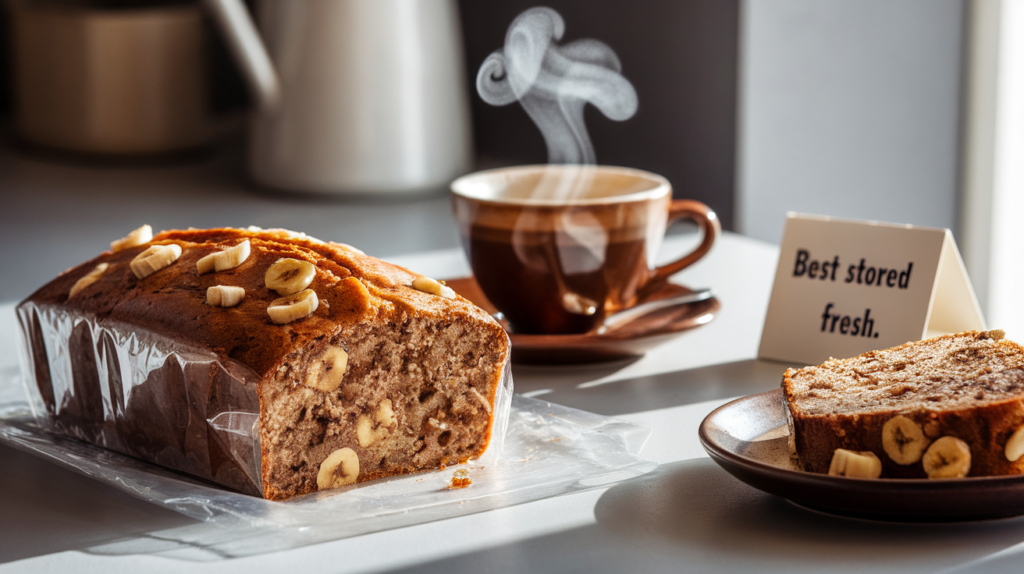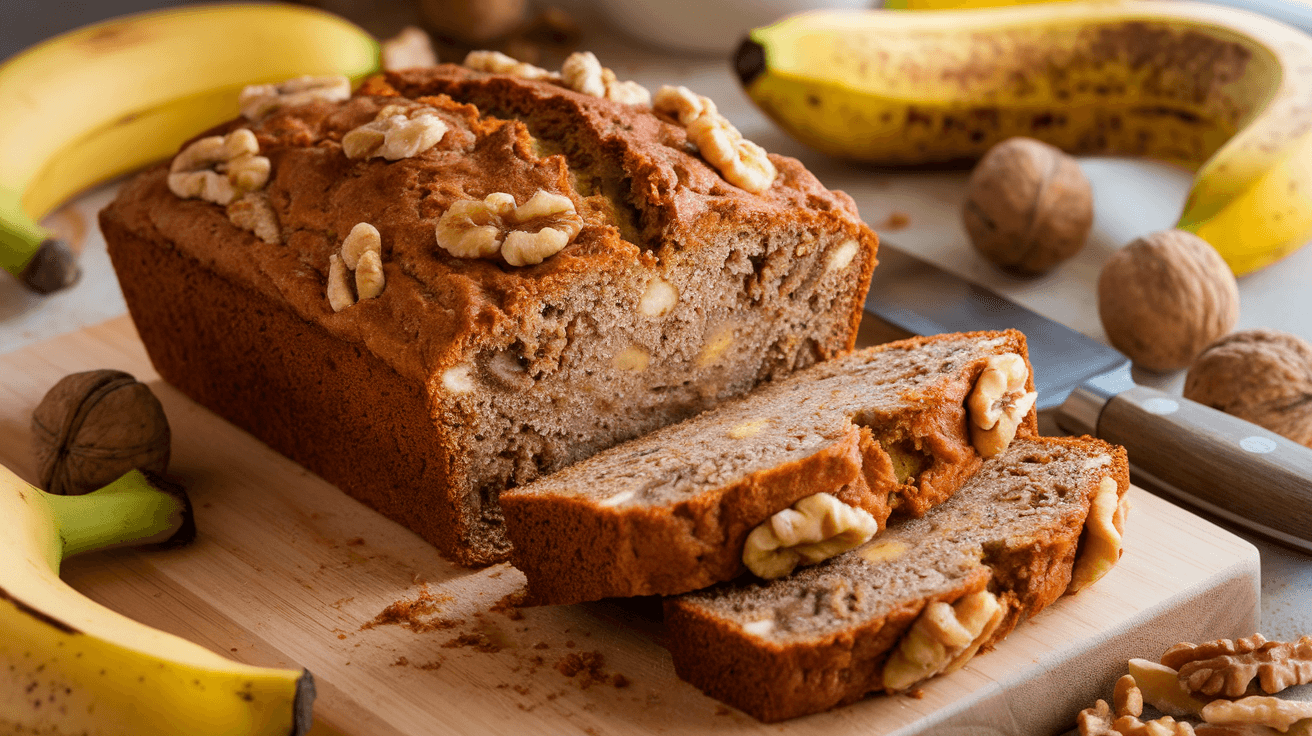Introduction
Banana nut bread is a beloved baked good, known for its rich flavors and moist texture. However, achieving that perfect moist consistency can sometimes be tricky. Many home bakers encounter challenges, such as bread that turns out too dry or crumbly, leaving them wondering what went wrong.
Moisture is a critical aspect of banana nut bread’s appeal. When baked correctly, it offers a satisfying bite that pairs perfectly with the natural sweetness of bananas and the crunch of nuts. In this article, we’ll explore the most common reasons why banana nut bread might not be moist and provide practical tips to ensure you get perfect results every time.
From understanding ingredient ratios to avoiding common baking mistakes, this guide will help you troubleshoot and refine your recipe so your banana nut bread stays soft, flavorful, and irresistibly moist.

Why Key Ingredients Matter for Moist Banana Nut Bread
How Bananas Affect the Moisture in Banana Nut Bread
Bananas are the star ingredient in banana nut bread, and their ripeness directly impacts the bread’s moisture. Overripe bananas with brown spots are ideal because they contain more natural sugars and moisture. Using under-ripe bananas can result in drier, less flavorful bread.
Choosing Nuts That Complement Moist Banana Nut Bread
Nuts like walnuts or pecans not only add texture but also influence the overall moisture of the bread. Toasted nuts can enhance flavor without absorbing too much moisture, while raw nuts may contribute to dryness if they soak up liquid during baking.
Balancing Wet and Dry Ingredients for Perfectly Moist Banana Nut Bread
A balanced ratio of wet to dry ingredients is essential for moist banana nut bread. Ingredients like flour, sugar, and baking soda should be measured accurately to avoid an overly dry or dense texture. Incorporating enough wet ingredients, such as bananas, eggs, and oils, ensures the bread stays moist throughout.
Why Overripe Bananas Are Key to Moist Banana Nut Bread
Overripe bananas not only break down easily during mixing but also release more natural moisture and sweetness. If you have trouble ripening bananas quickly, you can place them in a brown paper bag or bake them in the oven at a low temperature to soften them.
Common Baking Mistakes That Make Banana Nut Bread Dry
Overmixing the Batter
One of the most common mistakes when making banana nut bread is overmixing the batter. While it’s tempting to ensure everything is well combined, overmixing activates gluten in the flour, leading to dense and dry bread. To avoid this, gently fold the ingredients until just combined.
Baking Time and Temperature Errors
Incorrect baking time or temperature can significantly affect the moisture level in your banana nut bread. Baking at a temperature that’s too high can cause the edges to overcook before the center is fully baked, leading to dryness. Always use a thermometer to check your oven’s accuracy and bake at the recommended temperature, typically 350°F (175°C).
Incorrect Measurements
Using the wrong ratios of wet to dry ingredients is another culprit behind dry banana nut bread. For example, too much flour can absorb excess moisture, while insufficient liquid ingredients like eggs or oil can result in a crumbly texture. Be precise when measuring, and consider weighing ingredients for accuracy.
Skipping or Misusing Key Ingredients
Leaving out critical ingredients like eggs, butter, or oil can drastically reduce moisture. Additionally, substituting these ingredients without accounting for their moisture content—such as using low-fat alternatives—can result in a less moist final product. If you’re making substitutions, be sure to choose options that retain or enhance moisture, like Greek yogurt or applesauce.
The Role of Wet Ingredients in Keeping Banana Nut Bread Moist

Choosing the Right Type of Fat
The fat you use in your banana nut bread significantly impacts its moisture. Butter adds a rich flavor, but oil often produces a moister texture because it remains liquid at room temperature. Consider using vegetable oil, canola oil, or even coconut oil for a soft, tender crumb.
The Role of Eggs
Eggs not only provide structure but also contribute to the bread’s moisture. Using the right amount of eggs is crucial—too few can lead to dry bread, while too many may make the texture too dense. For a richer and moister loaf, consider adding an extra egg yolk.
Adding Dairy for Moisture
Dairy ingredients like buttermilk, yogurt, or sour cream can elevate the moisture level in banana nut bread. These ingredients also add a subtle tanginess that enhances flavor. When incorporating dairy, reduce other liquids slightly to maintain balance.
Incorporating Natural Moisture Enhancers
Natural ingredients like applesauce or mashed pumpkin can replace or complement traditional wet ingredients. These options not only add moisture but also enhance the overall flavor profile. Experimenting with these substitutions can lead to unique and delicious results.
Best Preparation Techniques for Moist Banana Nut Bread
Prepping Your Baking Pan
The way you prepare your baking pan can influence how moist your banana nut bread turns out. Using a non-stick pan and greasing it lightly with butter or oil helps prevent the edges of the bread from drying out. For even better results, line the pan with parchment paper to retain more moisture.
Mixing the Batter Properly
Properly combining your ingredients is key to achieving moist banana nut bread. Start by mixing wet and dry ingredients separately before gently folding them together. Avoid vigorous stirring, as it can overwork the batter and result in a denser texture.
Letting the Batter Rest
Allowing the batter to rest for 10–15 minutes before baking can help hydrate the dry ingredients more effectively. This step also allows the baking soda or powder to activate, resulting in a lighter, moister loaf.
Avoid Overbaking
Overbaking is a common mistake that leads to dry banana nut bread. Check for doneness by inserting a toothpick into the center of the loaf; it should come out with a few moist crumbs, not completely clean. Remove the bread from the oven as soon as it’s baked, and let it cool in the pan for 10–15 minutes before transferring to a wire rack.
Covering the Bread While Cooling
Once the bread is out of the oven, covering it loosely with a clean kitchen towel during the cooling process helps trap steam, keeping the loaf moist. Avoid wrapping it too tightly, as this can make the crust soggy.
How to Store and Serve Banana Nut Bread to Retain Moisture

Proper Storage to Retain Moisture
Storing your banana nut bread correctly is essential to preserving its moisture. Once fully cooled, wrap the bread tightly in plastic wrap or aluminum foil to lock in the moisture. For added protection, place the wrapped loaf in an airtight container or resealable plastic bag.
Refrigeration and Freezing Tips
If you plan to enjoy the bread within a week, refrigerate it to maintain freshness. However, refrigeration can sometimes dry out baked goods, so consider placing a piece of paper towel inside the storage container to absorb excess moisture. For long-term storage, freezing is the best option. Wrap the bread in plastic wrap, followed by a layer of aluminum foil, and freeze for up to 3 months.
Reheating for Best Results
When reheating banana nut bread, use a microwave or oven to warm individual slices gently. To prevent drying out, place a damp paper towel over the bread if microwaving or wrap it in foil if using the oven. This step ensures the bread retains its original moist texture.
Serving Suggestions
Banana nut bread is best served slightly warm, with optional toppings like a smear of butter, cream cheese, or a drizzle of honey. Pair it with a hot cup of coffee or tea for the ultimate comfort treat. The moisture and flavor of the bread often enhance after resting for a day, making it an even more delightful experience.
Enhancing Flavor and Moisture with Add-Ins
Incorporating Moisture-Rich Ingredients
Adding moisture-rich ingredients can elevate the texture and flavor of your banana nut bread. Consider folding in ingredients like shredded coconut, grated zucchini, or mashed avocado. These additions not only add depth to the flavor but also contribute to a softer, moister loaf.
Using Sweet Additions
For an extra touch of sweetness and moisture, try adding honey, maple syrup, or brown sugar to the batter. These natural sweeteners help retain moisture while giving your bread a rich, caramelized flavor.
Infusing with Fruits
Fresh or dried fruits like blueberries, diced apples, raisins, or dried cranberries can add bursts of flavor and moisture to banana nut bread. When using dried fruits, soak them in warm water or juice for a few minutes before folding them into the batter to prevent them from absorbing moisture during baking.
Adding a Streusel or Glaze
Enhance the moisture and flavor of your banana nut bread by topping it with a streusel made from butter, sugar, and flour. Alternatively, drizzle a simple glaze made from powdered sugar and milk over the cooled bread. These additions not only boost flavor but also help seal in moisture.
Experimenting with Spices
Spices like cinnamon, nutmeg, or cardamom can complement the natural sweetness of bananas and add warmth to the flavor profile. While these don’t directly impact moisture, they elevate the overall taste, making the bread feel richer and more indulgent.
Advanced Tips for Perfectly Moist Banana Nut Bread
Using Steam During Baking
To maintain moisture during baking, try creating a steamy environment in your oven. Place a small pan of hot water on the lower rack while the bread bakes. The steam helps prevent the outer layer from drying out, keeping the loaf tender and moist.
Adding a Syrup Soak
If your banana nut bread turns out slightly dry, a simple syrup soak can rescue it. Combine equal parts sugar and water, heat until dissolved, and lightly brush the syrup over the surface of the cooled bread. This adds both moisture and a hint of sweetness.
Experimenting with Different Flour Types
Using alternative flours like almond flour or oat flour can contribute to a moister texture. These flours retain moisture differently than traditional all-purpose flour, often yielding a softer loaf. If using them, adjust the liquid ingredients slightly to maintain the right consistency.
Making Mini Loaves
Smaller loaves or muffins retain moisture more effectively than larger loaves because they bake more evenly. If you find that full-sized banana nut bread tends to dry out, try dividing the batter into smaller pans and reducing the baking time accordingly.
Layering the Batter with Add-Ons
For added texture and moisture, layer your batter with spreads like cream cheese or nut butter before baking. Spread a thin layer in the middle of the batter, creating a moist and creamy surprise when you slice into the bread.
Keeping It Covered During the Last Few Minutes
If your bread’s edges or top brown too quickly, cover it loosely with aluminum foil during the last 10–15 minutes of baking. This prevents the surface from drying out while allowing the center to bake fully.
FAQs
Why does my banana nut bread come out dry even though I follow the recipe?
Dry banana nut bread can occur even when following a recipe due to factors like overmixing the batter, baking for too long, or inaccurately measuring ingredients. Ensure your bananas are overripe, and double-check your wet-to-dry ingredient ratios.
Can I substitute oil for butter to make my banana nut bread more moist?
Yes, substituting oil for butter often results in a moister loaf because oil remains liquid at room temperature. Consider using vegetable, canola, or coconut oil for the best results.
How can I make my banana nut bread moister after it’s baked?
If your bread is already baked, you can restore some moisture by brushing it with a light sugar syrup or reheating it with a damp paper towel in the microwave. Store it wrapped tightly to preserve the texture.
Can I use frozen bananas for banana nut bread?
Absolutely! Frozen bananas work well for banana nut bread. Thaw them completely and discard any excess liquid before incorporating them into the batter to avoid affecting the moisture balance.
Why does my banana nut bread dry out after a day?
If your bread dries out quickly, it may not have been stored properly. Wrap it tightly in plastic wrap or aluminum foil and store it in an airtight container to lock in moisture.
Can I add extra bananas for more moisture?
Adding more bananas can increase moisture, but too many can make the bread dense and gummy. Stick to the recipe’s recommended amount or replace a portion of the fat with extra banana puree for a slight adjustment.
Conclusion
Banana nut bread is a timeless favorite, but achieving that perfect moist texture requires attention to detail. By choosing the right ingredients, avoiding common baking mistakes, and using proper preparation techniques, you can create a loaf that’s soft, flavorful, and irresistibly moist. Remember to store it properly to maintain its texture, and don’t hesitate to experiment with substitutions like yogurt or oil for added moisture.
With these tips, you’ll be able to troubleshoot and refine your recipe, ensuring your banana nut bread is perfect every time. Happy baking!

